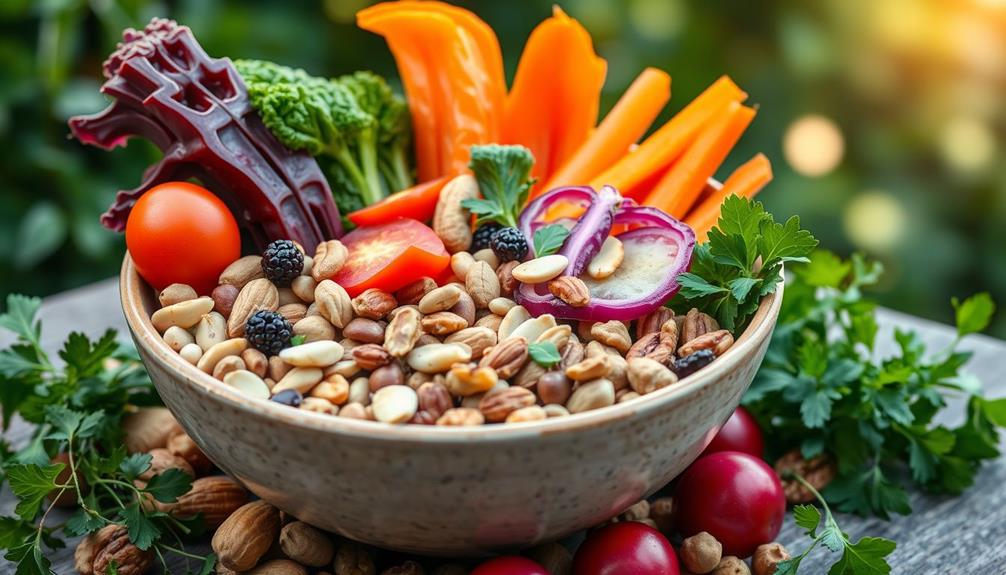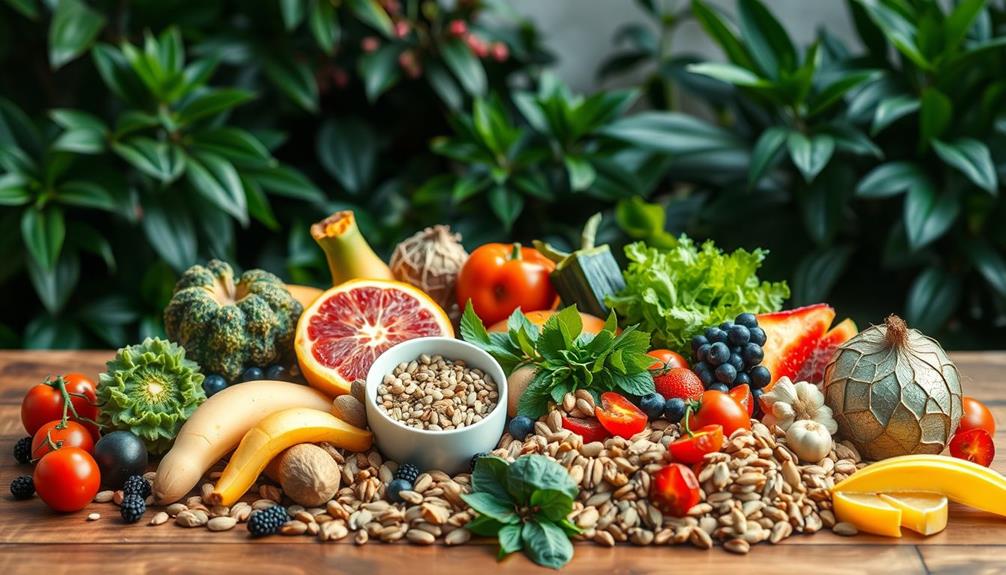A raw food diet can potentially help alleviate some arthritis symptoms due to its anti-inflammatory properties, but it isn't a cure. This diet focuses on uncooked, plant-based foods rich in antioxidants and fiber, which may reduce inflammation and improve joint health. However, evidence supporting raw foods as a definitive solution for arthritis is limited. It's important to approach this diet thoughtfully, considering nutritional needs to avoid deficiencies. Many individuals report positive changes, but these experiences can vary widely. If you're curious about specific benefits and recommendations, there's more to explore on this topic.
Key Takeaways
- A raw food diet, rich in fruits and vegetables, may alleviate arthritis symptoms through its anti-inflammatory properties and high antioxidant content.
- Nutritional deficiencies, particularly in vitamin B12 and protein, can arise from a raw food diet if not properly planned for arthritis patients.
- Anecdotal evidence suggests individuals have experienced symptom relief and increased energy after adopting a raw food diet for arthritis management.
- Research indicates that diets high in raw plant foods may lower inflammatory markers, potentially benefiting arthritis sufferers.
- Integrating raw foods into a balanced diet can enhance overall health, but it is essential to monitor nutritional needs for effective management of arthritis.
Understanding Arthritis and Its Types
Arthritis affects over 100 different types of joint inflammation, with rheumatoid arthritis (RA) being one of the most prevalent. About 1.3 million adults in the U.S. suffer from RA, and women are 2-3 times more likely to develop this condition than men.
Understanding the symptoms of rheumatoid arthritis is vital for early diagnosis and management. In addition to RA, individuals may experience other inflammatory conditions, such as cold medications overview that can exacerbate joint pain. You might experience pain, swelling, stiffness, and a decreased range of motion in your joints. These symptoms can greatly impact your daily life, making it essential to recognize them early on.
Unlike osteoarthritis, which is typically associated with wear and tear on joints, RA is an autoimmune disorder that leads to chronic inflammation and joint damage.
In addition to RA, other types of arthritis include gout, caused by uric acid crystal accumulation in the joints, and various forms linked to age and lifestyle factors. The prevalence of arthritis increases as you get older, making it a major health concern for older adults.
Understanding the different types of arthritis and their symptoms helps you seek appropriate treatment and improve your quality of life.
The Raw Food Diet Explained

The raw food diet focuses on eating uncooked and unprocessed foods, emphasizing fruits, vegetables, nuts, and seeds for their nutrient density.
Many proponents believe that this diet can enhance overall health and boost energy levels, similar to how coffee lovers appreciate the various brewing methods that affect flavor and caffeine content, especially with different brewing methods.
You might find that this approach offers various health benefits, but it's crucial to be aware of potential risks, especially regarding nutrient deficiencies.
Understanding the core principles of the raw food diet can help you make informed choices about incorporating it into your lifestyle.
Raw Food Principles
A raw food diet centers on consuming uncooked and unprocessed plant-based foods, such as fruits, vegetables, nuts, and seeds. This approach is rooted in the belief that raw foods retain more nutrients and enzymes compared to their cooked counterparts.
By focusing on these foods, you can incorporate a wealth of anti-inflammatory foods into your meals, which some believe may help reduce arthritis symptoms. Additionally, the high antioxidant content found in these foods may contribute to overall health improvement, similar to the benefits of Cranberry Juice Consumption, which is rich in antioxidants.
The raw food diet is typically rich in antioxidants and compounds that combat inflammation, potentially providing relief for those suffering from arthritis. Followers often report benefits like increased energy levels and improved digestion, which can positively impact overall health and well-being.
However, it's crucial to be mindful of certain nutritional considerations, as you may need to supplement with vitamin B12 and vitamin D to avoid deficiencies common in strict raw food diets.
While the raw food diet offers many advantages, striking a balanced approach that includes both raw and cooked foods can guarantee you meet your nutritional needs. By doing so, you'll support your body better and maintain a healthy, diverse diet that caters to your lifestyle and health goals.
Nutrient Density Benefits
Eating a raw food diet offers remarkable nutrient density benefits that can enhance your overall health. By focusing on uncooked and unprocessed plant-based foods, you're packing your meals with essential vitamins, minerals, and antioxidants. This approach promotes not just general wellness but also targets inflammation, which can be particularly beneficial if you're dealing with arthritis.
Additionally, incorporating essential oils for inflammation relief can complement the anti-inflammatory effects of your diet.
Consider the following key benefits of a raw food diet:
- High in Dietary Fiber: Supports digestive health and aids in weight management—important for arthritis sufferers.
- Rich in Phytochemicals: These compounds may inhibit inflammatory pathways, providing potential relief from arthritis symptoms.
- Cholesterol-Free: Plant foods lack cholesterol, which can support cardiovascular health and reduce the risk of comorbidities that worsen arthritis.
- Antioxidant-Rich: Helps combat oxidative stress, further aiding in reducing inflammation.
Embracing the nutrient density of raw foods can greatly contribute to your anti-inflammatory efforts and overall health benefits.
While a balanced approach with both raw and cooked foods is ideal for the best nutrient intake, focusing on raw foods can be a powerful step toward wellness.
Potential Health Risks
While the nutrient density of a raw food diet offers significant advantages, it's important to contemplate potential health risks associated with this eating pattern. One major concern is nutritional deficiencies. If you don't carefully plan your meals, you might lack essential nutrients like vitamin B12, iron, and calcium, which are crucial for your immune system and overall health.
Additionally, some essential oils, such as lavender and chamomile, may help soothe stress and anxiety that could arise from dietary changes.
Moreover, the high fiber content typical of raw diets can lead to digestive challenges. You might experience discomfort or gastrointestinal issues, especially if your body isn't used to such a drastic increase in fiber. For those with higher energy needs, like athletes or growing children, meeting caloric requirements can be quite difficult on a strict raw food diet.
Additionally, some raw foods can harbor harmful bacteria or pathogens if not handled properly, increasing your risk of foodborne illnesses. Long-term adherence to a raw food diet without proper nutritional guidance can result in imbalances that may negatively affect your health and wellbeing.
As a result, while exploring the benefits, you must also weigh these potential risks carefully.
Anti-Inflammatory Properties of Raw Foods

Many people find that incorporating raw foods into their diet can greatly reduce inflammation, especially for those dealing with arthritis. These foods are packed with antioxidants and anti-inflammatory properties, which help combat oxidative stress and lower inflammation levels.
According to research, the significance of song placement can also be reflected in dietary choices, where the right combination of raw foods may enhance their beneficial effects. By focusing on raw fruits and vegetables, you can benefit from phytochemicals that may inhibit inflammatory pathways, potentially easing arthritis symptoms.
Here are some benefits of raw foods for inflammation:
- Rich in Antioxidants: Fruits and vegetables provide essential nutrients like vitamins A, C, and E, known for their anti-inflammatory properties.
- Elimination of Processed Foods: A raw food diet removes processed ingredients that often contribute to inflammation.
- Variety of Nutrients: Consuming a diverse range of raw foods guarantees you're getting a wide array of vitamins and minerals that support overall health.
- Lower Inflammatory Markers: Some studies suggest that diets high in raw plant foods may lead to reduced levels of inflammatory markers.
Anecdotal Evidence and Personal Stories

Stories from those who've adopted a raw food diet often provide powerful insights into its effects on arthritis. Take Agathe Mathieu, for instance. After three months on a raw food diet, she regained hand function and experienced a disappearance of rheumatoid arthritis symptoms after nine years of struggle.
Additionally, many individuals have reported increased energy levels, which may enhance their ability to engage in regular physical activity, a factor known to support joint health and mobility. Then there's Clive Langton, who initially approached the raw food diet with skepticism. Yet, after 18 months, he reported significant health improvements, including a youthful blood count and a sense of overall wellness.
These personal stories contribute to a growing body of anecdotal evidence suggesting that individuals on raw diets often experience increased energy levels and improved health. Many who attend raw food seminars share transformative experiences, which can inspire greater commitment to exploring plant-based dietary options.
Some even highlight the benefits of consuming herbal teas like chamomile and ginger, which may complement a raw food lifestyle by alleviating discomfort and promoting relaxation, best herbal tea for period pain.
While these narratives are compelling and highlight the potential benefits of a raw food diet for those suffering from arthritis, they also underscore the need for further scientific investigation. Personal stories can be influential, but they can't replace rigorous research into the long-term effects of a raw food diet on arthritis and overall health.
Scientific Research on Raw Food Diet

Scientific research on the raw food diet reveals promising insights into its potential benefits for individuals with arthritis. Studies indicate that a raw food diet, rich in uncooked and unprocessed foods, may be packed with anti-inflammatory components and antioxidants, possibly alleviating arthritis symptoms. Furthermore, the high content of fiber and nutrients in raw fruits and vegetables can contribute to overall improved health and digestion. Additionally, many advocates of the raw food diet point to reasons for eating raw food, such as increased energy levels, weight loss, and improved skin complexion. These potential benefits make the raw food diet an attractive option for individuals looking to manage their arthritis symptoms naturally.
This dietary approach may also resonate with individuals experiencing emotional dysregulation, as seen in conditions like Borderline Personality Disorder, where diet can play a role in overall emotional stability. While a small study showed participants reporting improvements in joint pain and swelling, it's important to note that these results were self-reported and based on a limited sample size.
Here are some key points to reflect upon:
- Followers of a raw food diet often experience increased energy levels, which could encourage more physical activity.
- Improved overall health may indirectly benefit those with arthritis by aiding in weight management.
- Vitamin B12 supplementation is vital, as a raw food diet can lead to deficiencies that may affect your health.
- Although anecdotal success stories exist, thorough scientific research is still needed to firmly establish the effectiveness of this dietary approach for managing arthritis symptoms.
As you explore the potential of a raw food diet, keep in mind that more evidence is necessary to draw definitive conclusions about its role in treating inflammatory diseases.
Potential Benefits for Arthritis Management

A raw food diet offers potential advantages for managing arthritis symptoms, thanks to its emphasis on fresh, uncooked fruits and vegetables that are naturally rich in anti-inflammatory properties and antioxidants. This approach aligns with the principles of providing a proper diet for overall health, similar to how hamster care guidelines suggest focusing on nutritious foods.
By focusing on these foods, you may help reduce inflammation associated with arthritis, leading to improved joint function and symptom relief. Many individuals following a raw food diet have reported personal success stories, noting significant improvements after several months of dietary changes.
The high fiber content of this diet can support gut health, which plays a vital role in inflammation management. A healthy gut may prevent the buildup of harmful intestinal bacteria that can exacerbate inflammatory diseases like arthritis.
Incorporating a variety of raw foods guarantees a diverse nutrient intake, which is essential for overall health.
However, while embracing this diet, it's important to pay attention to nutritional considerations, especially vitamin B12 and protein intake. Making sure you're meeting these needs will help maintain your health while managing arthritis symptoms effectively.
Risks and Limitations of Raw Food Diet

When you switch to a raw food diet, you might face nutritional deficiencies, especially in important vitamins like B12 and D.
As with any major dietary change, it's vital to consult with a financial advisor to evaluate the potential long-term benefits and risks associated with your health investments, including risk management strategies for dietary choices.
Additionally, the high fiber content can lead to digestive issues, making it hard to meet your caloric needs.
It's important to weigh these risks against the potential benefits for managing arthritis.
Nutritional Deficiencies Concerns
Nutritional deficiencies pose significant risks for those following a raw food diet, often leading to serious health concerns. If you're not careful, you may end up lacking essential nutrients that your body needs to function effectively.
Consider these potential deficiencies:
- Vitamin B12: Essential for nerve function and the production of red blood cells, often absent in raw vegan diets.
- Vitamin D: Important for bone health, and hard to obtain from raw foods alone, especially if you're not getting enough sunlight.
- Omega-3 fatty acids: Key for reducing inflammation, these are typically found in fatty fish, making them hard to source on a raw diet.
- Protein: Sufficient intake can be challenging, as you need to consume larger volumes of raw foods.
Long-term adherence to a raw food diet without careful planning can lead to deficiencies in calcium, iron, and other essential nutrients.
Regular monitoring and supplementation may be necessary to mitigate these risks. It's crucial to strike a balance between raw and cooked foods to guarantee you're meeting your nutritional needs effectively.
Digestive Issues Potential
Digestive issues can arise for many people adopting a raw food diet, primarily due to its high fiber content from fruits and vegetables. While fiber is important for gut health, an abrupt increase can lead to bloating, gas, and diarrhea, especially if your body isn't used to it. If you have digestive disorders like irritable bowel syndrome (IBS), these symptoms can worsen.
Additionally, the absence of cooked foods might leave you feeling fatigued due to insufficient caloric intake. Raw food diets can also lack essential nutrients, including vitamin B12 and vitamin D, which are critical for overall health.
Here's a look at some potential digestive issues and their emotional impact:
| Digestive Issue | Emotional Impact |
|---|---|
| Bloating | Discomfort and frustration |
| Gas | Embarrassment |
| Diarrhea | Anxiety about outings |
Balancing your diet can be challenging when relying solely on raw foods. If not planned carefully, you risk nutrient imbalances that can affect your well-being. Always listen to your body and consult a healthcare professional before making significant dietary changes.
Dietary Recommendations for Arthritis

A well-rounded diet can notably impact arthritis management. Focusing on anti-inflammatory foods can help reduce arthritis pain and improve your overall well-being.
Here are some dietary recommendations you might find beneficial:
- Embrace a Plant-Rich Diet: Fill your plate with fruits and vegetables, as they're packed with antioxidants that combat inflammation.
- Try the Mediterranean Diet: This diet emphasizes whole grains, lean proteins, and healthy fats, all of which are linked to lower disease activity in arthritis.
- Incorporate Omega-3 Fatty Acids: Foods like flaxseeds and walnuts can notably reduce inflammation, supporting joint health.
- Limit Inflammatory Foods: Cut back on fried items, sugary beverages, and processed meats to manage your arthritis symptoms effectively.
Integrating Raw Foods Into a Balanced Diet

Integrating raw foods into a balanced diet can greatly enhance your nutrition and support arthritis management. Aim for approximately 75% raw foods to maximize your intake of essential vitamins, minerals, and antioxidants. These nutrients play a vital role in reducing inflammation and improving overall health.
By combining raw fruits and vegetables with whole grains, legumes, and healthy fats, you amplify the anti-inflammatory properties of your meals. This combination not only tastes great but also provides ample dietary fiber, which supports digestive health.
To guarantee you're getting enough protein and micronutrients, plan your meals carefully. Some nutrients, like vitamin B12, may require supplementation, especially if you're increasing your raw food intake.
Incorporate a variety of raw dishes such as vibrant salads, nutrient-packed smoothies, and tasty raw snacks to make your diet enjoyable and sustainable.
Frequently Asked Questions
Can Raw Food Diet Help With Arthritis?
A raw food diet might help with arthritis by providing anti-inflammatory benefits. You may experience less joint pain and more energy, but guarantee you meet your nutritional needs to avoid potential deficiencies that could worsen symptoms.
Can Arthritis Be Reversed by Diet?
Imagine planting seeds in a garden; while diet can nourish your health, it won't erase arthritis' roots. You can't reverse it solely through food, but adopting an anti-inflammatory diet may ease your symptoms alongside medical treatment.
What Foods Aggravate Arthritis the Most?
Foods that aggravate arthritis the most include fried items, sugary drinks, red and processed meats, refined carbs, and unhealthy fats. You should limit these to help manage inflammation and potentially alleviate your symptoms.
What Can You Do for Unbearable Arthritis Pain?
To manage unbearable arthritis pain, focus on anti-inflammatory foods, stay active within your limits, practice stress relief techniques, and consult healthcare professionals for a tailored plan. Cold or heat therapy can also provide immediate comfort.
Conclusion
In summary, while a raw food diet may not cure arthritis, it can serve as a powerful ally in managing its symptoms. Think of it as a rejuvenating breeze on a hot day—invigorating and revitalizing. By incorporating raw foods into your diet, you can potentially reduce inflammation and improve your overall well-being. Just remember, it's crucial to consult with a healthcare professional before making significant dietary changes to guarantee it's the right fit for you.

















